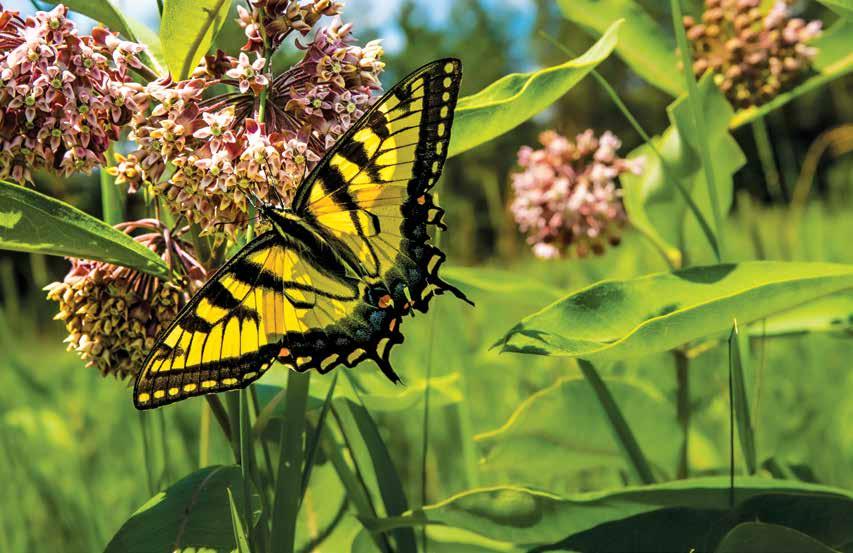Spring 2025



Willsboro, Essex County | 68 acres
The Adirondack Land Trust in fall 2024 purchased 68 acres on Willsboro Point for ecological conservation and community benefit. The parcel features 950 feet of natural shoreline on Lake Champlain’s Willsboro Bay, open fields, and shrublands. The area provides habitat for more than 130 bird species, including American kestrel, indigo bunting, great crested flycatcher, and long-eared owl.
The land trust acquired the parcel as a first step toward protecting it as municipal parkland. Next, the town will purchase the parcel from the land trust.
“We are delighted to be partnering with the Town of Willsboro on this project,” says Adirondack Land Trust Executive Director Mike Carr. “It is a positive example of what we can accomplish together when interests align.”
“As parkland, this property will be of great value to the quality of life in our town,” says Willsboro Town Supervisor Shaun Gillilland. “We will use grant funding to purchase all 68 acres. Opportunities like this are few and far between.”
Willsboro Point, the most densely populated area in the town, has limited public access to the lake. And even though Willsboro has more Lake Champlain shoreline than any other town in Essex County, there are few public locations from which to view or access the lake.
The conservation and community benefits of this collaborative project include:
• Securing opportunities for waterfront access and community walking trails to foster health and wellness
• Safeguarding a drinking water source by preventing harmful runoff into Lake Champlain
• Preserving grassland and shoreline habitat for birds
• Maintaining the scenic character of Willsboro Point
A Lake Champlain Basin Program grant for Land Acquisition and Conservation for Clean Water and Healthy Ecosystems will enable the town to purchase the parcel and begin a community planning process.
(More stories on pages 4-5)

Last spring, the Adirondack Land Trust asked you to brainstorm a name for our newest preserve—and you answered! You sent in more than 100 suggestions for what to call the 187-acre parcel at the corner of Route 73 and Adirondack Loj Road outside Lake Placid. And your ideas led to High Meadow Preserve.
The name High Meadow Preserve signals what people can expect when they pass by or stop at the pull-off: A welcoming view of the High Peaks Wilderness from a flat, open area. Thank you to everyone who shared ideas and heartfelt stories expressing a deep connection to this place.
Advisory Directors
Vinny McClelland
Bill McKibben
Amy Vedder, Ph.D.
Chairs Emeriti
BOARD OF DIRECTORS
Stephen H. Burrington, Chair
David Henle, Vice Chair
Elizabeth McLanahan, Vice Chair
Timothy Fritzinger, Treasurer
Anne C. Stuzin, Secretary
Robert C. Andolina
David Brunner
Charles Canham, Ph.D.
Shaun Gillilland
Lisa Guide
Heidi Kretser, Ph.D.
Brian T. Majeski
Joe Martens
Amy McCune, Ph.D.
Catherine McGraw
Peter S. Paine, Jr.
Donella Rapier
Holly Rippon-Butler
Robert J. Trainor
Julie Willis
Lionel O. Barthold
James C. Dawson, Ph.D.
Harry Groome
Edward W. McNeil
William L. Paternotte
Meredith M. Prime
Charles O. Svenson
Melissa Cascini
Adeline Clayton, Co-Chair
Josh Cook
Evan Foster
Maya Fuller
Daniel Galvin, Co-Chair
Jess Grant
Olivia Jobe
Lura Johnson
Carlie Leary
High Meadow Preserve sits within a vast area once known as South Meadows lake, a water body formed approximately 10,000 years ago by retreating glaciers that deposited fine sands along the bottom. Over time, soil accumulated and a forest took hold. In the 19th and early 20th centuries, Native American artifacts were unearthed when land was cleared for agriculture and trees were cut for lumber and paper mills.
The basin initially formed by glaciers still functions as a frost pocket that holds cold air coming down from nearby mountains. Consequently, Lake Placid is often colder than high-altitude mountain towns across the United States. This could explain why heart-leaved paper birch trees are found on the preserve, where elevation climbs from 1,699 feet along the edge of the West Branch of the Ausable River to 2,008 feet near Adirondack Loj Road, although the species is typically associated with spruce-fir forests at higher elevations.
Learning about High Meadow Preserve’s ecological communities and human history helps to inform a management plan that balances future public access with habitat and wildlife protection. n
Safa Mammeri
Abigail Omaña
Cassandra Prenn-Vasilakis
Mohamed Sahraoui
Renee Seacor
Charlotte Staats
Maddie Stuzin, Secretary
Emma Ticknor, Committee Liaison
Gabrielle Ursin
Naishaly Vélez Galán
Brooke Wise
Mike Carr, Executive Director
Kimberly Corwin-Gray, Associate Director of Philanthropy
Olivia Dwyer, Communications Specialist
Becca Halter, Stewardship & GIS Manager
Chris Jage, Conservation Program Director
Connie Prickett, Director of Communications
Derek Rogers, Stewardship Manager
Susie Runyon, Finance & Operations Manager
Joe Scrimenti, Office Administrator
Megan Stevenson, Land Protection Manager
Mary Thill, Grants Manager
Aaron Thomas, Farmland & Stewardship Specialist
Nancy Van Wie, Director of Philanthropy
Sophie Williams, Intern (2025)
Kathy Woughter, Philanthropy & Outreach Coordinator
Adirondack Land Trust 2861 NYS Route 73 PO Box 130, Keene, NY 12942 (518) 576-2400 info@adirondacklandtrust.org adirondacklandtrust.org

Elizabeth “Betsy” Folwell passed away at her home in Blue Mountain Lake on January 5, 2025. She was 71. Betsy joined the Adirondack Land Trust’s Board of Directors in 2022, sharing knowledge she accumulated over decades exploring the Adirondack Park and its communities as a writer and editor of Adirondack Life magazine.
She understood the Adirondacks better than anyone we knew.
“She understood the Adirondacks better than anyone we knew,” says Adirondack Land Trust Executive Director Mike Carr. “This is a loss for all of us, and for the Adirondacks.”
At home in Blue Mountain Lake, Betsy and her husband, Tom Warrington, volunteered for the fire department and countless local efforts. They helped meet other community needs by starting businesses, including a brief but storied stint running a grocery store. Her contributions to arts and cultural institutions spanned roles at the Adirondack Experience, Adirondack Lakes Center for the Arts, and the founding of the Adirondack Center for Writing.
“No one loved the Adirondacks or did more to share what she found and learned than Betsy did,” says Adirondack Land Trust Board Chair Steve Burrington. “We were fortunate to have her in our midst.”
Betsy’s writing, collected in the book “Short Carries: Essays from Adirondack Life,” could make larger-than-life events viscerally human, such as her tale of getting her nose bloodied by a Russian spectator at the Miracle on Ice hockey game or her story of sharing coffee and sticky buns with the crew aboard the last train from Tahawus. And for anyone who has imagined making maple syrup, following turtles on their spring migrations, catching smelt, or finding a bear in your kitchen, Betsy’s words attuned us to the natural rhythms of the Adirondacks.
While Betsy lost her sight later in life, she continued to write, paddle, and explore the place she loved. She was and remains a visionary for an Adirondack future where nature and people thrive. In the 1980s, she helped thousands of readers understand the toxic legacy of DDT and the urgent threat of acid rain to Adirondack waters and forests. Betsy also saw how privately conserved lands—in and out of the Adirondack Park—play an important role in helping wildlife find habitat, food, and mates in an age of rapid change. Her lived experience continues to inform the Adirondack Land Trust’s efforts to welcome people with disabilities to nature preserves. Betsy’s memory will be found forever in these mountains, waters, and wild places, and her voice will echo forever in Adirondack hearts. n
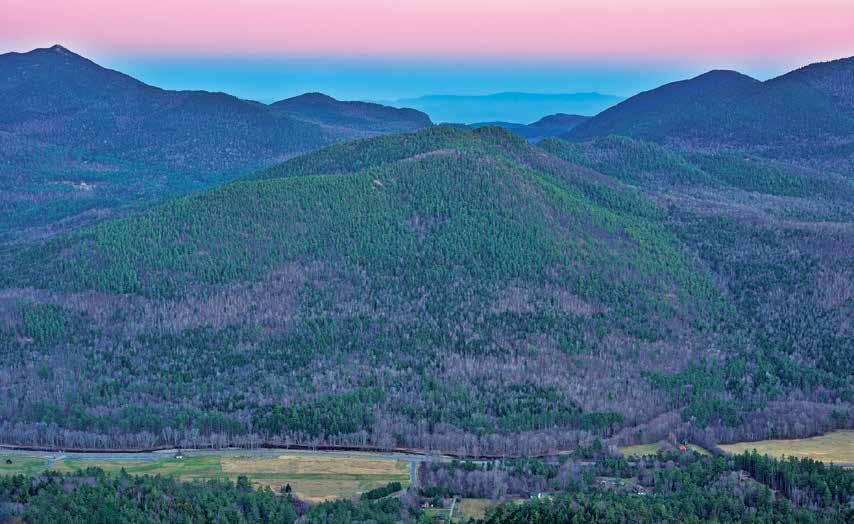

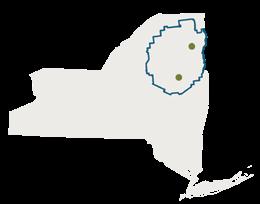
Keene, Essex County | 107 acres
In October 2024, the Adirondack Land Trust transferred 107 acres on the western shoulder of Baxter Mountain above the East Branch of the Ausable River to the forever wild Forest Preserve. Conservation outcomes include:
• Expanding a contiguous block of Forest Preserve surrounding Baxter Mountain, a popular hiking destination
• Extending natural shoreline protection to 1.4 miles along a section of the East Branch of the Ausable River, helping to mitigate damage from flood risks associated with intensifying storms
• Preventing development that can cause erosion on steep slopes
• Preserving a scenic vista from Route 73 and other mountain summits
The land trust gratefully accepted this parcel as a donation from Chris and Audrey Hyson in 2022 and then gifted the land to the state.
Wells, Hamilton County | 78 acres
The benefits of this community-inspired conservation project include:
• Adding 60 acres to the forever wild Forest Preserve adjacent to the Siamese Ponds Wilderness
• Protecting 1.1 miles of natural shoreline along Griffin Gorge, a dramatic section of the East Branch of the Sacandaga River known for its unique rock formations and cascading falls
• Securing a public access easement on 18 acres to enhance recreational access to the Wilcox Lake Wild Forest and creating an opportunity to establish a sustainable tourism hub at the same site
The Adirondack Land Trust and New York State Department of Environmental Conservation worked together to acquire a combined 78 acres from the the estate and heirs of Fernando Sisto. Thirty-seven acres were donated directly to the state in June 2024 and 41 acres were purchased for $80,000 by the land trust in September 2024.
Thanks to guidance from additional partners, including Adirondack Hamlets to Huts, Town of Wells, Hamilton County Industrial Development Agency, and Adirondack leader Bill Farber, these land transactions were configured with an eye toward achieving ecological, social, and economic benefits. After the state secures a public access easement from the land trust on an 18-acre roadside parcel, we will donate the parcel to Adirondack Hamlets to Huts, a nonprofit organization creating community-based hut-to-hut trail routes throughout the Adirondacks. Their long-range goal for the site is to transform it into a lodging and education facility to support outdoor recreation excursions, foster stewardship of conservation lands, interpret local history, and promote personal wellness.
A climate resilience grant from The Nature Conservancy and a grant from the J.M. McDonald Foundation aided the Adirondack Land Trust’s land purchase. n
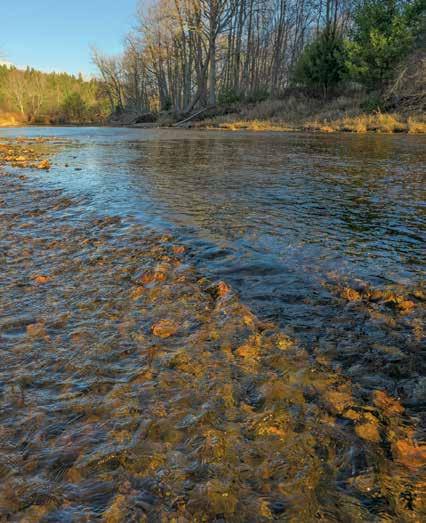
Since 1984, the Adirondack Land Trust has protected 131 miles of natural shoreline on rivers, streams, lakes, and ponds. Natural shoreline is another way of saying riparian buffer — a transitional area between land and water.
Conserving riparian buffers allows them to:
• Absorb and slow water from heavy rains to reduce flood risk
• Filter runoff to prevent sediments and pollution from entering waterways
• Keep water cool for species like brook trout
• Provide habitat and pathways for wildlife
• Store carbon to mitigate climate change

Ben Wever Farm in Willsboro, N.Y., received the Hugh Hammond Bennett Conservation Production Award in February 2025. This prestigious award is given to one recipient each year by the National Association of Conservation Districts (NACD), the nonprofit advocacy organization that represents the 3,000 conservation districts nationwide.
NACD recognized proprietors Shaun and Linda Gillilland for their community engagement as chair of the Essex County Board of Supervisors and executive director of the Cornell Cooperation Extension of Clinton County, respectively, as well as their “holistic and forward-thinking approach to farming.”
We extend our congratulations to Shaun and Linda and are proud to partner with them to conserve 295 acres featuring agricultural fields and shoreline forests at Ben Wever Farm.

Stewardship & GIS Manager Becca Halter in May 2024 received a master’s certificate in geographic information system (GIS) technology from the University of Wisconsin–Madison. Her skills bolster the Adirondack Land Trust’s capacity for spatial analysis and cartographic data visualization, which helps assess conservation values and landscape context for specific lands, as well as show land protection accomplishments in compelling ways. Scan this QR code to see Becca’s Boquet River salmon habitat restoration map—complete with her salmon-inspired cardinal direction symbol.


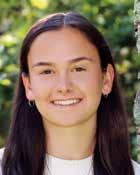
Sophie Williams, who hails from New Jersey and is working toward a bachelor’s degree in geography at the University of Oxford, England, has been selected as this year’s intern. Her skills and experience include geographic information systems technology, serving as media committee director for the Oxford Climate Society, and conducting a survey of how people’s experiences of mobility in parks differ. Sophie’s project for the Adirondack Land Trust will involve documenting locations of universally accessible wildland trails across the Adirondacks. Knowing what areas are lacking these opportunities will help us identify potential overlap between land conservation and community needs.
“Our jobs are to do what we can, when we can,” says Virginia Rose (left), the founder of Birdability, a nonprofit that enhances access to birding for people with disabilities and other health challenges. At a January 2025 virtual event, Virginia shared accessibility tips and the Birdability Map, a crowdsourced map that shares accessibility features at birdwatching sites worldwide. Virginia has used a wheelchair since experiencing a spinal cord injury at age 14. She began birding 17 years ago and discovered her best self in nature— an opportunity she wants for everyone. Scan the QR code to see Virginia’s presentation on our YouTube channel.

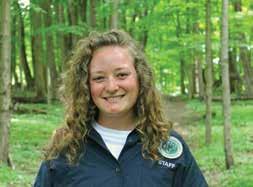


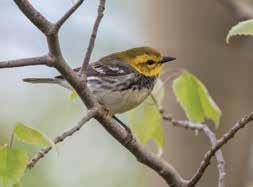

Sign up to join free events and field trips at adirondacklandtrust.org
High Meadow Preserve, Lake Placid | Sunday, May 18, 10 a.m. to noon
Join Melissa Cascini, a certified Leave No Trace instructor and member of the Adirondack Land Trust Next Generation Council, to learn how to minimize environmental impact while enjoying the outdoors.
Glenview Preserve, Harrietstown | Sunday, June 22, 1 to 4 p.m.
Join botanist Dan Spada to learn how to identify 10 trees, focusing on common Adirondack species. Offered in partnership with the New York Flora Association.
Keene | Thursday, June 26, 4:30 to 6:30 p.m.
The Adirondack Land Trust’s Next Generation Council and Adirondack Midstory invite young professionals, interns, and seasonal staff in their 20s and 30s to celebrate the start of summer at this casual gathering.
High Meadow Preserve, Lake Placid | Friday, August 29, 7 to 10 a.m.
See and hear which species pass through the High Peaks region each fall on this outing with Adirondack Land Trust Stewardship Manager Derek Rogers.
Lake Placid | Sunday, September 21, 8 to 9:30 a.m.
Bring your meditation practice outside with the Adirondack Land Trust’s Joe Scrimenti, who will lead participants through grasslands and along the banks of the Ausable River.
This July and August, we’ll travel the Adirondacks to share conservation updates, listen, learn, and celebrate summer. Find us in Paul Smiths on Thursday, July 10, Blue Mountain Lake on Thursday, July 31, and check our website for details and additional places.


Sign up for Adirondack Land Trust email updates and you’ll hear from us when we conserve vast forests, pristine shorelines, productive farm fields, and other important lands and waters. Plus, we bring the flora, fauna, and wild places of the Adirondacks straight to your inbox with wildlife videos, details on upcoming events and field trips, and stories from the land.


